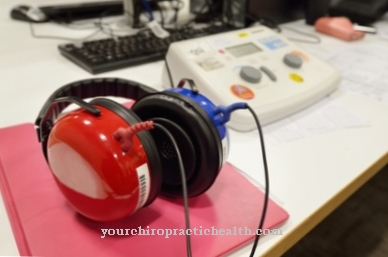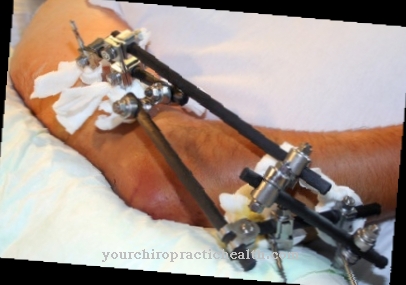During apheresis, the patient's blood is fed into a centrifuge by means of a hose system, where the individual blood components of the plasma are separated into different layers by gravity. In this way, with a Leukocyte apheresis for example, leukocytes can be "washed" in a targeted manner from the patient's blood. This method is relevant, for example, in the context of autoimmune diseases.
What is leukocyte apheresis?

The therapeutic procedure of apheresis is colloquially called Blood washing designated. The blood is cleaned of excess components. The process takes place extracorporeally and thus outside the patient's body, in that the pathogenic substances are removed via a catheter, similar to dialysis.
The pathogenic substances can be proteins, protein-bound substances or whole cells that are present in the blood plasma. The patient receives the purified blood back after the cleaning. The leukocyte apheresis is a subform of the apheresis, which is about the cleaning of the plasma of leukocytes. These are white blood cells that are sometimes involved in the defense against pathogens or other foreign structures. Leukocytes are part of the immune system. Apheresis of the immune cells is particularly necessary if the cells are present in an unusually high concentration and are harmful to the patient. This can be the case, for example, in the context of autoimmune reactions.
Function, effect & goals
Leukocyte apheresis is used to treat various autoimmune diseases. For example, the therapy method can be used in the context of multiple sclerosis and has already established itself as a therapy for acute relapses, especially in patients with abnormal reactions to cortisone.
Autoimmunological processes are directed against the body's own tissue and cause inflammation in this tissue. In leukocyte apheresis, excess leukocytes are removed from the patient's blood plasma in order to combat autoimmune inflammation, for example. Therapeutic apheresis has already been established in various forms. In addition to the unselective, complete substitution of the plasma, there is also the selective plasmapheresis, in which a filtration or adsorption separates pathogenic and surplus substances from the plasma and leads the purified plasma back into the patient's body.
The leukocyte apheresis thus corresponds to a selective apheresis. In the apheresis procedure, the donor's blood is taken from a vein using a catheter, for example the leg or jugular vein. A closed, sterile hose system that can only be used once is connected to the catheter. The blood flows into the tubing system, where a small amount of anticoagulant solution is added to prevent blood from clotting within the system. The mixture of blood and anticoagulant moves through the tube system into a centrifuge, which creates an artificial gravity field. The blood components separate into individual layers in this field depending on their density.
In this way the leukocytes can be collected. All other blood components are returned to the patient via the closed hose system. The apheresis procedure can take up to two hours to complete. Apheresis procedures are only carried out in an inpatient setting and require regular monitoring of the plasma, since further blood components may be washed out during apheresis and must then be replaced.
You can find your medication here
➔ Medicines to strengthen the defense and immune systemRisks, side effects & dangers
In most cases, apheresis procedures are not very stressful for the patient. The most common side effects are reactions to the administered anticoagulant, such as a metallic taste in the mouth and a tingling sensation on the lips or extremities. Nausea occurs only in rare cases.
A feeling of coldness is also conceivable during the procedure. After leukocyte apheresis, patients with poor circulation are advised not to sit up too stormily or even to get up in a hurry. The patient's circulation should recover for at least five minutes after the apheresis. Fainting fits only in extreme cases after the apheresis. An extreme case also occurs when the anticoagulant is not sufficiently broken down by the patient's liver.In such a case, leukocyte apheresis can permanently restrict blood clotting. In such cases there is a temporary tendency to bleed and the coagulation must be normalized again with donated blood.
This is also the case if too many physiologically necessary substances have been removed from the blood together with the leukocytes. Since the leukocytes fulfill an immunological function, enough leukocytes must still be present in the blood after the apheresis to protect the patient from pathogens. Leukocytes are constantly being reproduced. In normal cases, the patients are not affected by a permanent impairment of the immune system. However, they are usually more susceptible to infections during therapy. If, for unknown reasons, leukocytes are not reproduced in sufficient quantities, substitution through a donation is also necessary in this context.
A special feature of leukocyte apheresis is that it can be used in the context of leukocyte donation. A certain amount of donor substance can be removed from a healthy person using the method. In contrast to whole blood donation, apheresis can obtain the blood components to be donated individually and in high purity. Apheresis methods are therefore also relevant in connection with donors and are considered the only methods to be able to obtain sufficient quantities of certain blood components from a donor. In this context, for example, modern cancer therapy benefits from apheresis procedures. As part of modern cancer therapy, apheresis technology enables, for example, the transplantation of blood stem cell preparations.












.jpg)

.jpg)
.jpg)











.jpg)